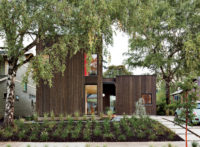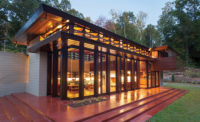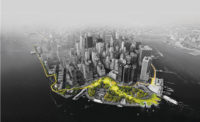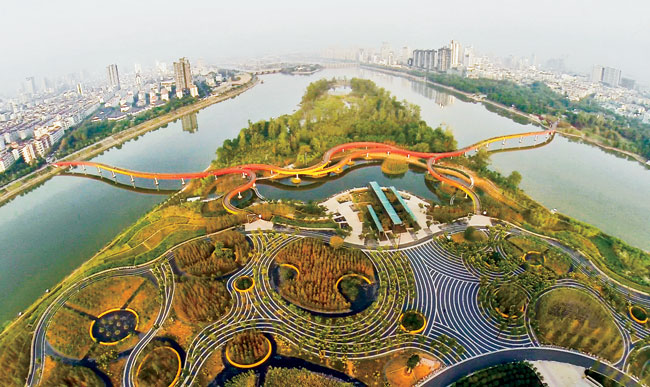Water and Resilience
Continuing Education: Turenscape Restores an Urban Wetland
Befriending the Floods: A Chinese landscape architect restores the ecology of an urban wetland and creates an innovative, ever-changing park.






















Kongjian Yu
Beijing
As the principal of China's largest landscape architecture firm and head of Peking University's architecture and landscape architecture department, Kongjian Yu has a spacious corner office in a sleek office building in Beijing's Haidian district. Turenscape, his 600-employee firm, fills three floors with conventional cubicles. But a handwritten sign taped to the doorjamb of Yu's private office hints at an unconventional design philosophy. It reads 'rain forest this way.'
The space is a jungle of ceiling-height potted plants that surround a desk, tables, and piles of books. It's a fitting metaphor for Yu's 'messy' and holistic alternative to China's typical land- and water-management practices. Yu aims to make public open spaces that are resilient in extreme events by incorporating what he refers to as 'the wisdom of the farmer.'
A recent Turenscape project that demonstrates this low-tech approach is the 50-acre Yanweizhou Park, situated at the confluence of the Yiwu and Wuyi rivers in Jinhua, a city of over a million people in Zhejiang Province, in the eastern part of the country. The Jinhua municipal government hired Turenscape to restore wetland areas that were damaged by sand quarrying, and to connect the park to the north and south districts of the city.
Yu and his team convinced skeptical city officials to replace the park's unsightly concrete floodwalls'which can cause downstream damage'with cut-and-fill terracing along the sloped riverbanks. The terraces, retained with undulating stone walls and sown with native riparian plants, absorb nutrients from the floodwaters. Similarly, the flat areas of the site, once mined for sand, were formed into a series of ponds. 'Capturing water in this way allowed the farmer to retain it for irrigation during the dry season,' says Yu, who grew up on a farm outside of Jinhua. The ponds also provide habitat for waterbirds and other wildlife.
As in the west, the typical approach to prevent flooding and control stormwater in China is to build defensive barriers and to pipe and channel runoff away from protected areas as quickly as possible. In contrast, at Yanweizhou, the landscape 'makes friends with the flood' by allowing floodwaters into the park, which is designed, like a natural wetland, to thrive even when inundated. In this way the high water becomes an observable event, and the landscape, instead of being damaged, is replenished, according to Yu.
The park can be enjoyed by the public during all times of year, even in monsoon season, since Turenscape's design includes a sinuous 2,300-foot-long pedestrian bridge that hovers over the water. The colorful structure, with its yellow and red tubular fiberglass railing meant to recall the dragon used in traditional festival dances, serves as a link across the river and to the site's existing opera house.
Even though the region, which receives 80 percent of its rainfall during the summer, is subject to frequent flooding, it also suffers from rapidly decreasing groundwater supplies. According to Yu, groundwater levels in much of the country are falling by 1 to 2 meters a year, in large part due to industrial-scale agricultural practices. Unlike typical park landscapes, Yanweizhou requires very little maintenance and no fertilization or irrigation. It also helps recharge the aquifers, using features such as permeable gravel, which contributes to the percolation of stormwater into the ground.
The park acts like a green sponge, purifying the water by absorbing pollutants. According to Yu, 75 percent of China's surface water is contaminated by industrial pollutants, organic waste from agriculture, and sewage.
'We can't just depend on sewage plants,' he says. Conventional wastewater treatment is expensive and contributes to air pollution, since it often relies on electricity from coal-fired power plants. But 2.5 acres of open space, using ecological strategies such as planted terracing, can clean about 260,000 gallons of water a day'the equivalent of a $1 million wastewater treatment system, according to Yu's estimates. Organic pollutants such as sewage damage the ecology of waterways, but they can serve as nutrients for vegetation, he explains.
At Yanweizhou, ecologically restorative open spaces attuned to the cycles of nature have replaced the aesthetic of the decorative garden. Yu is applying these principles to projects across China, and internationally'from a master plan for the Moscow River to a national water-management plan for Bangladesh. He maintains that, as environmental problems grow more urgent, building such resilient landscapes will become a matter of survival. 'The key,' says Yu, 'is to make them not only functional and productive but also beautiful.'
|
Continuing Education
 To earn one AIA learning unit (LU), including one hour of health, safety, and welfare (HSW) credit, read the three stories in the "Water and Resilience" section: "New Orleans Goes with the Flow"; "Befriending the Floods"; and "Flirting with Disaster". Then complete the test at architecturalrecord.com. Upon passing the test, you will receive a certificate of completion, and your credit will be automatically reported to the AIA. Additional information regarding credit reporting and continuing-education requirements can be found online at continuingeducation.bnpmedia.com. To earn one AIA learning unit (LU), including one hour of health, safety, and welfare (HSW) credit, read the three stories in the "Water and Resilience" section: "New Orleans Goes with the Flow"; "Befriending the Floods"; and "Flirting with Disaster". Then complete the test at architecturalrecord.com. Upon passing the test, you will receive a certificate of completion, and your credit will be automatically reported to the AIA. Additional information regarding credit reporting and continuing-education requirements can be found online at continuingeducation.bnpmedia.com.
Learning Objectives
1 Explain how green infrastructure can be used to bolster traditional hard infrastructure for flood control. 2 Describe how green infrastructure tactics can be used to remove pollutants from stormwater. 3 Discuss measures implemented by two recent art museums as protection from flooding. 4 Outline the testing regimen for hurricane-resistant glazing. AIA/CES Course #K1507A
For CEU credit, Read “Water and Resilience” and take the Quiz at continuingeducation.bnpmedia.com, or use our architectural record continuing-education app, available in the itunes store.
|















